Flexible energy to overcome the NG crisis
-Conversion to LPG for stable Supply-
Idioma : English / Español

1. World natural gas shortage – Urgent need for conversion to alternative energy
Due to the conflict between Russia and Ukraine, NG is now becoming a scarce resource. In many countries in the world, price of LNG had risen quite rapidly and we faced an Energy Crisis of which we cannot know how long it will last.
While the price of NG / LNG was becoming seriously expensive in the international market, LPG was once again being high-lighted as an alternative energy source.
We Kagla Vaportech Corp. is an expert of LPG supply devices such as vaporizers and surrounding equipment. Over 60 years of experience in LPG field, Kagla can propose an effective fuel transition from NG to LPG.
If you are facing any issues please feel free to contact!!
2. SDGs and fuel transition for better Eco-Friendly energy source

The first heat energy used by mankind was firewood. Then came coal, heavy oil, and light oil.
As environmental pollution became a concern, hydrocarbon fuels such as NG/LPG became popular as a clean energy source with low CO2 emissions.
In recent years, countries have set decarbonization goals and are making efforts to promote the SDGs., but fuel conversion is not an easy task. Carbon-free next-generation energy sources such as hydrogen and ammonia are still under development.
So in the meantime, we will use fuels that can keep CO2 emissions as low as possible to achieve a low-carbon society (Example: NG thermal power generation).
Many countries have high expectations for NG and LPG as low-carbon fuels.
However, in addition to the rising price of NG, economic sanctions triggered by Russia-Ukraine crisis have made it difficult to export Russian NG, and NG prices have skyrocketed. In some countries, NG prices are more than double the price of LPG.
Essentially, NG was favored because it was generally cheaper than LPG…that was the main reason (Other reasons include its lower carbon content and the fact that it is lighter than air, making it easier to ventilate…).
The price increase of gas directly leads to an increase in production costs, which in turn leads to an increase in product prices.
As the price of NG continues to rise, there is an urgent need to secure readily available alternative fuels. in order to avert a crisis of industrial and economic stagnation.
However, while the whole world is advocating decarbonized energy to curb global warming, it is hesitant to return to diesel and coal, which emit a lot of CO2.
Therefore, LPG, which is known as a low-carbon fuel like NG, is now attracting attention again. NG/LPG with low CO2 emissions will continue to be widely used as an important clean energy source while in transition!
Kagla proposes conversion to LPG and introduction of SNG as an alternative fuel for NG, whose price is rising.
3. Differences between LPG and NG
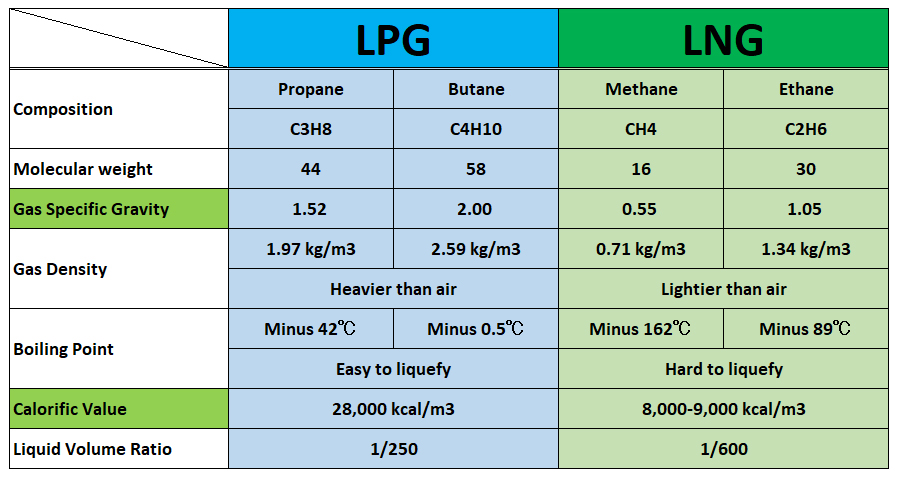
LPG (Liquefied Petroleum Gas):
Liquefies at relatively high temperature and low pressure, making it easy to store and transport.
Can be stored in a liquefied state in storage tanks or cylinders on each user’s premises, allowing for independent installation.
Quick recovery in case of emergency, as each installation is complete at its own location.
NG (Natural Gas):
liquefies at very low temperatures (see comparison table) and high pressure, so it is not easy to store and transport separately.
Therefore, NG is supplied to each user through pipelines.
Because of the huge cost of pipeline construction, it is difficult to supply NG to depopulated areas with small populations (That is why LPG is used in areas where NG cannot reach).
The tanks are not individual storage tanks, it is almost impossible to provide individual backups in the event of supply instability due to NG shortages, pipeline problems, etc.

As liquefaction of NG is not easy, NG is supplied in gaseous state from LNG receiving terminals through pipelines.
While on the other hand, LPG is supplied separately in liquid state, taking advantage of its easy condensation properties.
Since LPG is operated by installing individual storage and vaporization facilities, the risk of supply problems is extremely low, and it can be restored relatively quickly even if the infrastructure is destroyed by an earthquake or other natural disaster. In this respect, LPG is widely recognized as the best fuel for backup
4. Similarities between LPG and NG
LPG and NG are gases with different properties: LPG is composed mainly of Propane and Butane, while NG is composed mainly of Methane and Ethane.
LPG has a higher gas density and higher heat value, making it suitable for applications requiring higher heat value. In addition, it easily condenses at relatively high temperatures and low pressures, making it suitable for storage and distribution, and it is easy to restore facilities in an emergency.
In contrast, NG, which requires extremely low temperatures and high pressures for condensation, requires large-scale facilities for storage and transportation in liquid state, so it is supplied in gas state through pipelines. NG has a lower calorific value than LPG and is lighter than air while LPG is heavier than air.
Because of these differences in properties, combustion equipment for NG cannot basically be used with LPG due to the different combustion characteristics.
- LPG main components : Propane (C3H8) and Butane (C4H10)
- NG main components : Methane (CH4) and Ethane (C2H6)
However, looking at their chemical formulas as shown above, Propane, Butane, Methane, and Ethane all show that the atoms that make them up are Carbon and Hydrogen and thus these have similar structure.
Therefore, there is a backup method to generate synthetic gas (SNG), which has similar combustion characteristics to NG, by diluting LPG with air and adjusting it to be a substitute gas for NG.
Since LPG can be easily liquefied and stored in tanks, the installation of LPG tanks and related equipment to generate SNG as a substitute for NG or as a substitute gas itself is a method often applied to NG backup.
5. SNG and LPG : Advantages and Disadvantages as Backup for Natural Gas
When NG supply problems occur, it tends to be considered appropriate to use SNG, a synthetic natural gas, as an alternative gas because NG piping and combustion equipment can be used without modification.
But this is not always the case, depending on the background and circumstances requiring NG substitution.
In some cases, it may be more an advantage in the long run to convert the fuel to LPG by installing new piping, etc.
Following list compares the advantages and disadvantages of using SNG and LPG as NG replacement gases, respectively.
A comparative study of SNG and LPG is essential in selecting the optimal backup system according to the usage environment and facility conditions.

Facilities where SNG is suitable as NG back up
- Where there is a prospect of NG restoration
- Where there are many pipes and equipment for NG
- Where there is enough space for installation

Facilities where suitable for LPG is suitable as NG back up
- Where prospects for NG restoration are unclear
- Places with few NG piping and equipment
- Where alternative fuel is needed immediately
- Where space for installation is limited
6. Appropriateness of SNG and LPG as NG Backups in Different Situations
For example, if a temporary backup is needed due to a failure of the NG pipeline or receiving terminal, SNG system would be appropriate. The SNG system can be used for temporary equipment operation until NG supply is restored. And after NG supply is restored, SNG system can be used as backup equipment in case of unexpected troubles in future.
Now what should we do in a situation where the price of NG has soared and it is no longer profitable, rather than just a temporary problem with the natural gas supply?
For instance, the global natural gas crisis of 2022 was a complex issue involving international politics and the interests of various countries. As a result, it was extremely challenging to predict the time it would take for natural gas supply and market prices to return to normal levels.
In addition, under such circumstances, alternative fuels and the equipment to operate them are needed in large quantities and quickly. And another question is whether the production of SNG systems with complex mechanisms will be sufficient to meet the demand in each country.
Very honestly speaking, it was difficult.
Based on the above, Kagla would like to propose the following two approaches: (1) Introduction of an SNG system and (2) Conversion to LPG fuel.
(1) Introduction of SNG system
For facilities that are too large to use LPG fuel conversion and have sufficient space for installation, it is appropriate to consider an SNG system.
In addition to LPG supply facilities (storage tank, etc.), it is essential to install surge tanks of a size appropriate for the amount of gas consumed to ensure a stable supply of SNG. Therefore, even though it is a backup facility, it requires a certain large installation space and cost.
The production time for SNG system is relatively long compared to LPG equipment. Therefore, this point should also be taken into consideration when making a decision.
(2) LPG fuel conversion
If the outlook for normalization of NG prices is uncertain, if installation space is limited, or if alternative fuel is needed immediately, we recommend full conversion to LPG system.
Most NG facilities use high-pressure, large-diameter piping that is not suitable for use with LPG. So in many cases, piping construction to match the use for LPG is required when converting to LPG. Also, if the combustion equipment is not adjustable for both NG and LPG, it may be necessary to change to combustion equipment for LPG.
However, the advantages of LPG conversion include lower equipment costs and space savings due to its simple configuration, as well as a greater sense of stability due to the fact that LPG is operated directly with dedicated equipment.
If a stable supply of NG cannot be expected in recent years and the NG price is expected to rise further, full conversion to LPG system would be advantageous. Especially if the alternative fuel is in urgent demand, LPG equipment that is mass-produced as a standard product and shipped quickly is more suitable.
7. KAGLA’s SNG system (Propane-Air mixer) and LPG vaporizers
KAGLA prepares both SNG systems and LPG vaporizers. We shall assist to select matching system for NG back up
SNG system (Propane-Air mixer) EVM-AX5 series
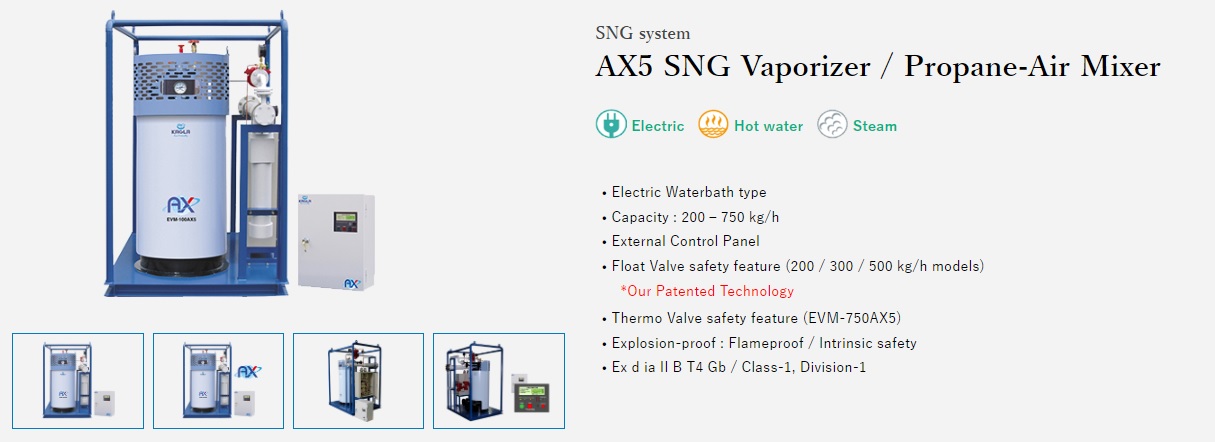 https://kagla.co.jp/en/product/ax5-mixer-sng/
https://kagla.co.jp/en/product/ax5-mixer-sng/
LPG vaporizer EV-AX5 series
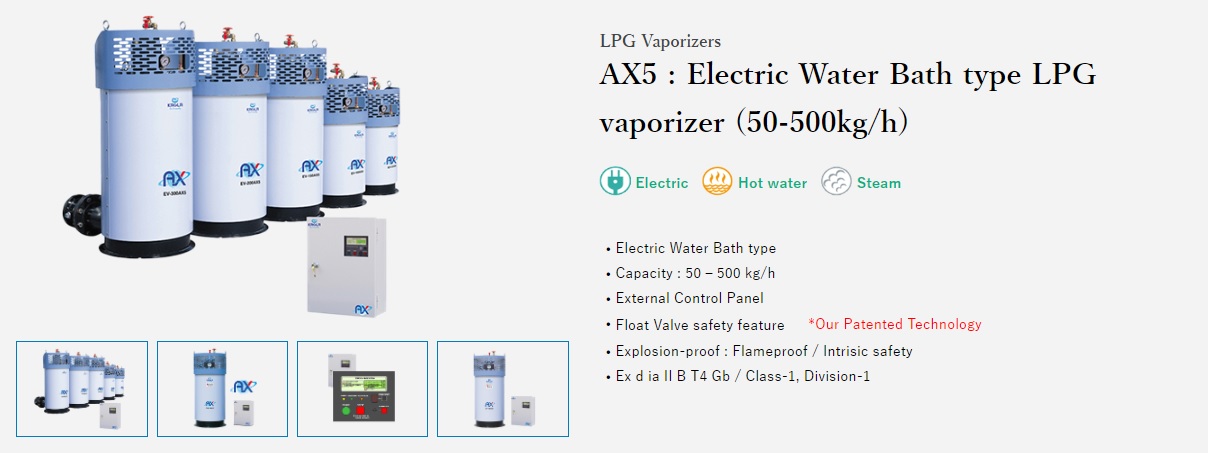 https://kagla.co.jp/en/product/ax5_vaporizer/
https://kagla.co.jp/en/product/ax5_vaporizer/
LPG vaporizer EV-750/1000AX5
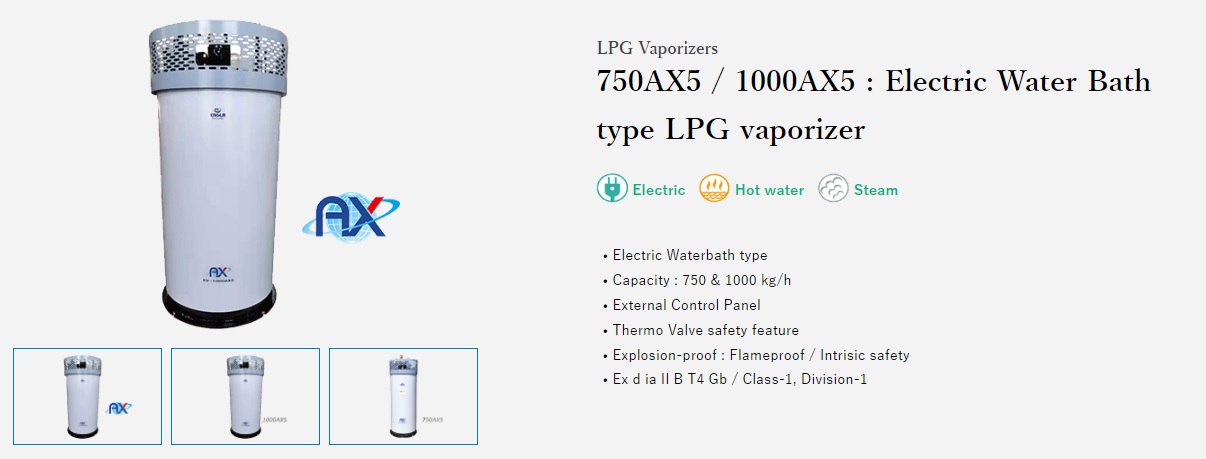 https://kagla.co.jp/en/product/750ax5-1000ax5/
https://kagla.co.jp/en/product/750ax5-1000ax5/
LPG vaporizer EV-CX series
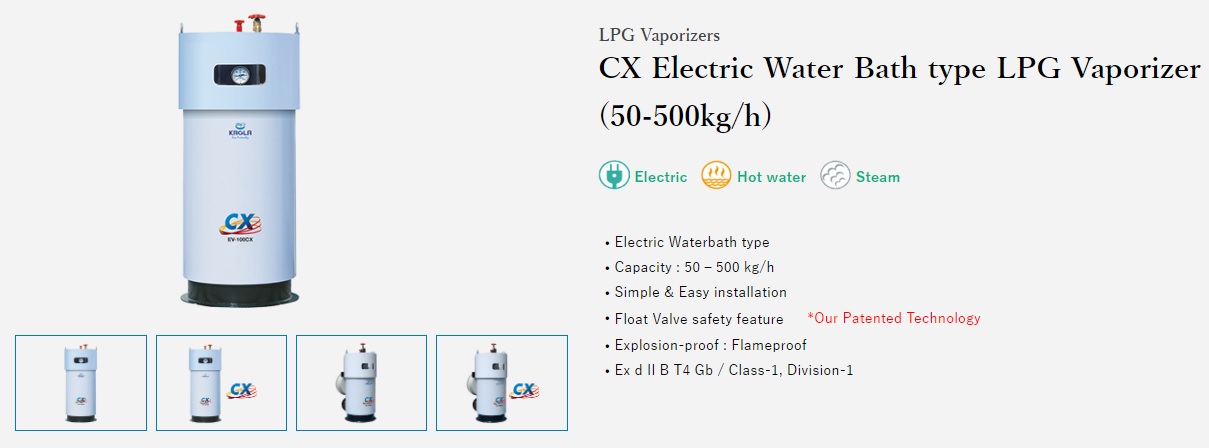 https://kagla.co.jp/en/product/cx-vaporizer/
https://kagla.co.jp/en/product/cx-vaporizer/
LPG vaporizer EV-45/55ADX
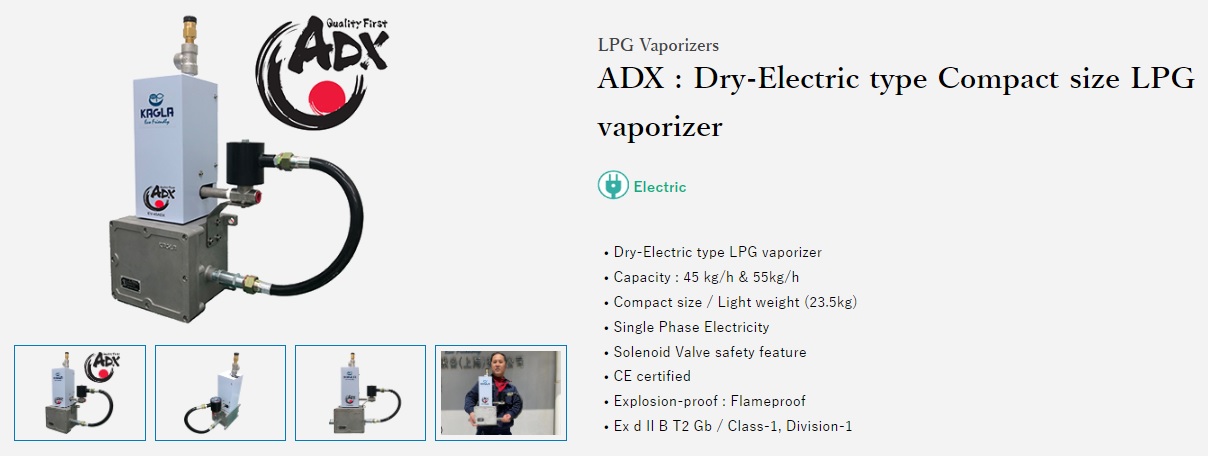 https://kagla.co.jp/en/product/adx-vaporizer/
https://kagla.co.jp/en/product/adx-vaporizer/
LPG vaporizer EV-100ADX
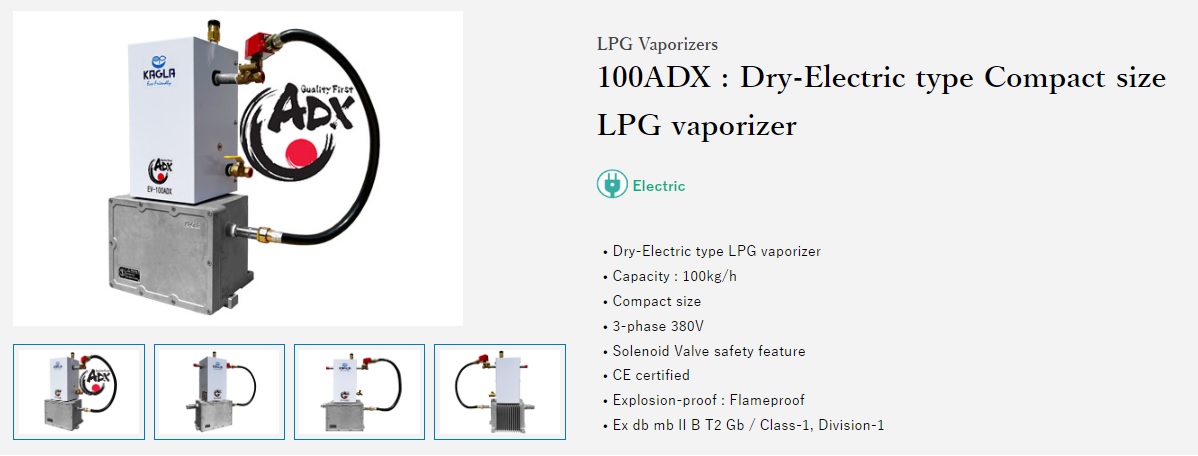 https://kagla.co.jp/en/product/100adx-dry-electric-type-compact-size-lpg-vaporizer/
https://kagla.co.jp/en/product/100adx-dry-electric-type-compact-size-lpg-vaporizer/
